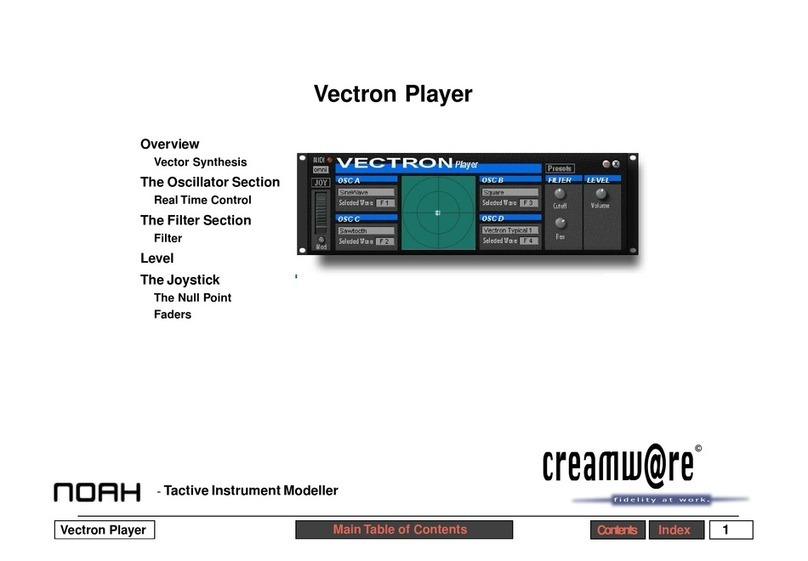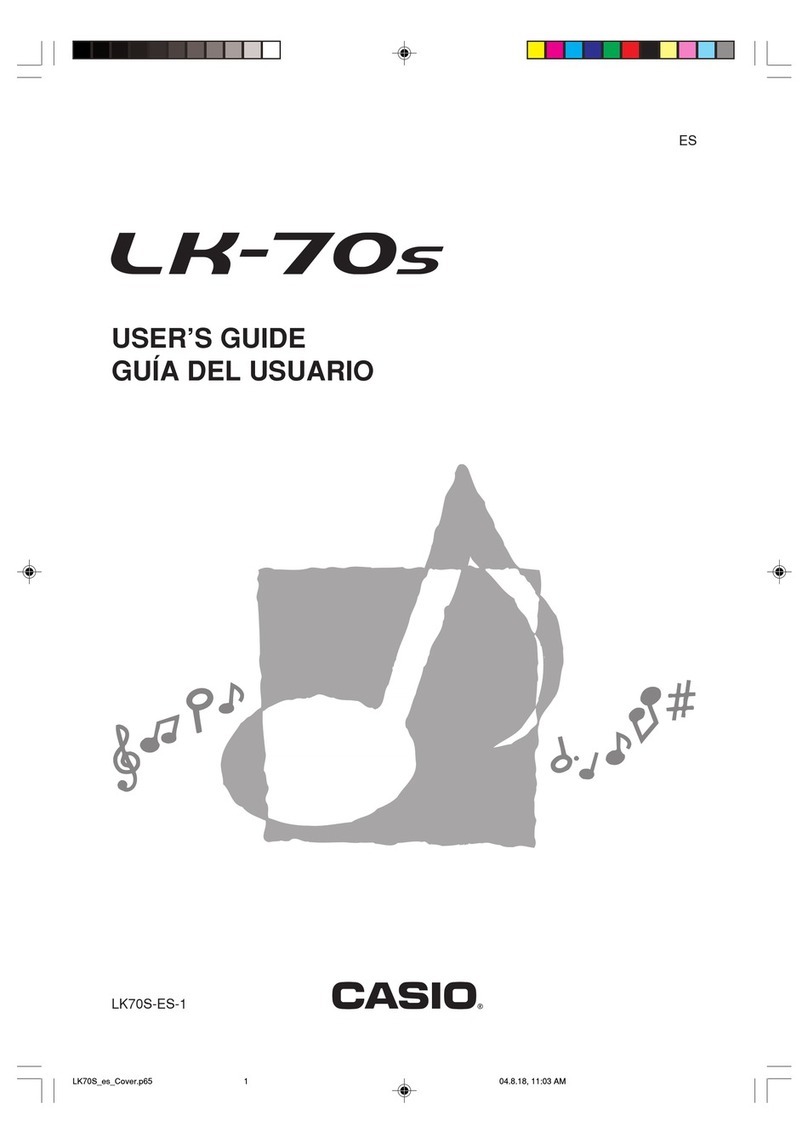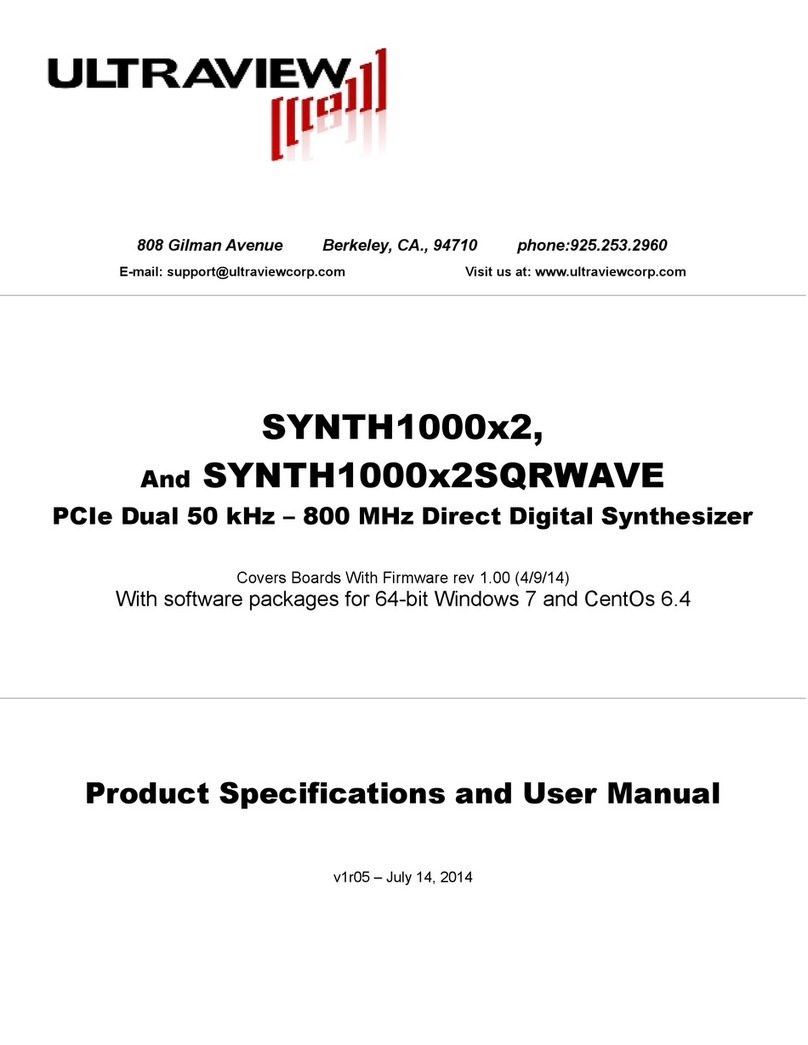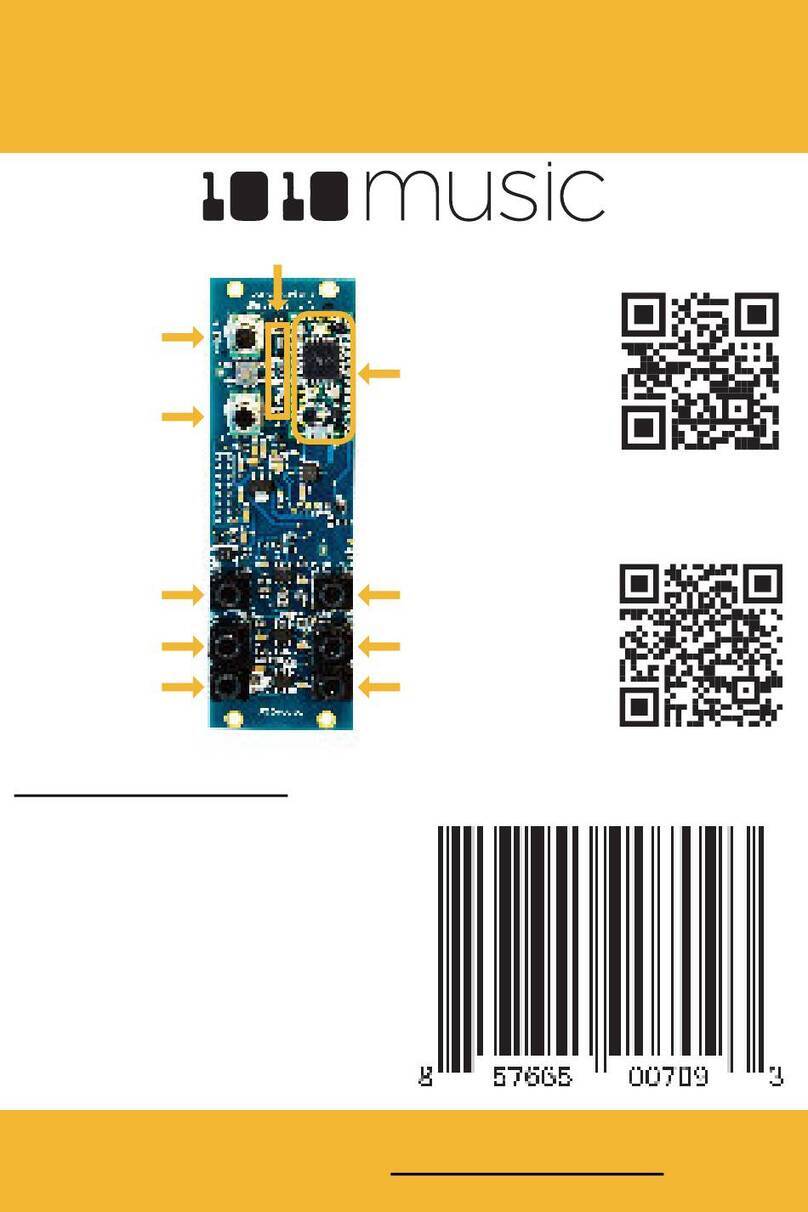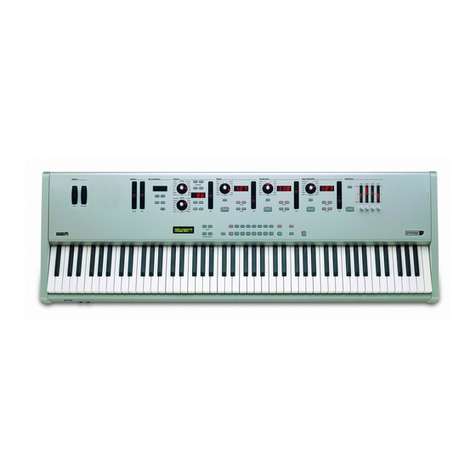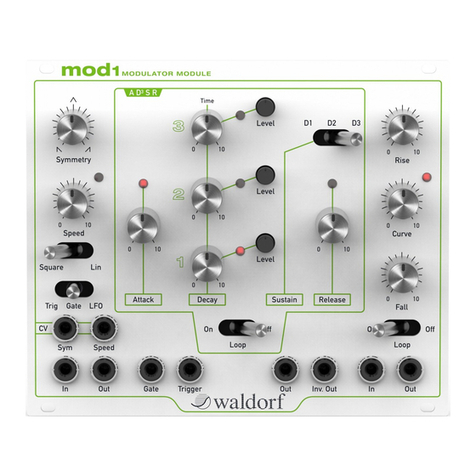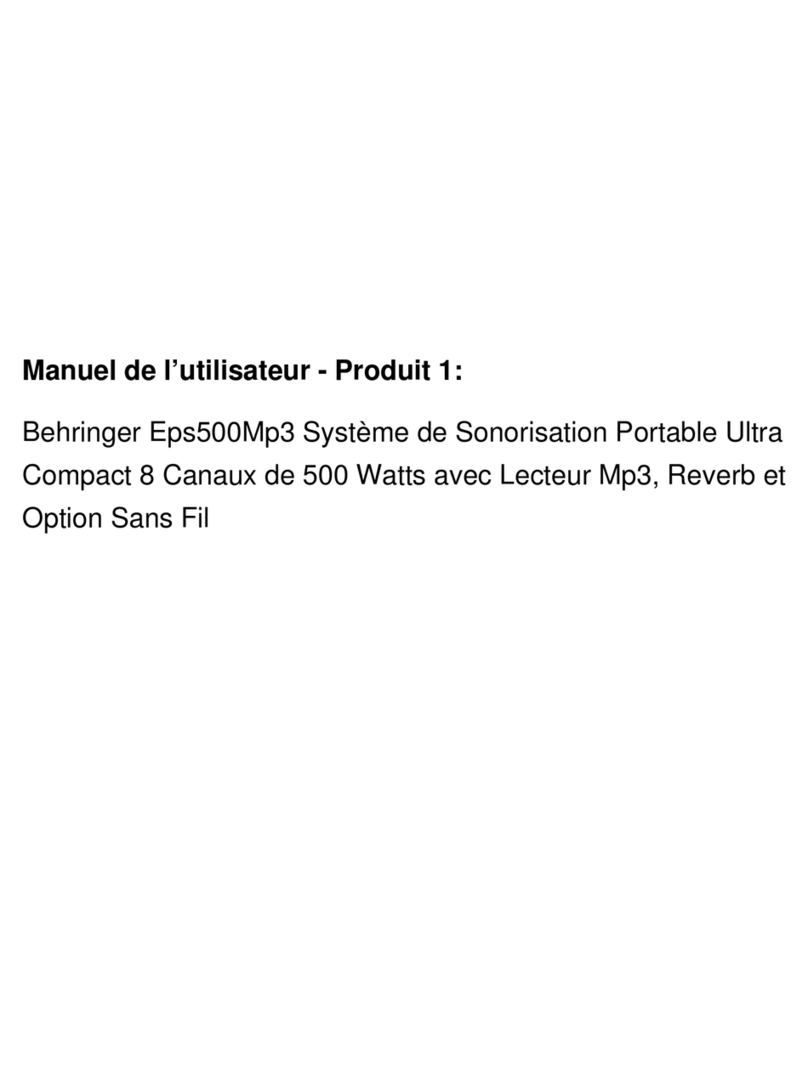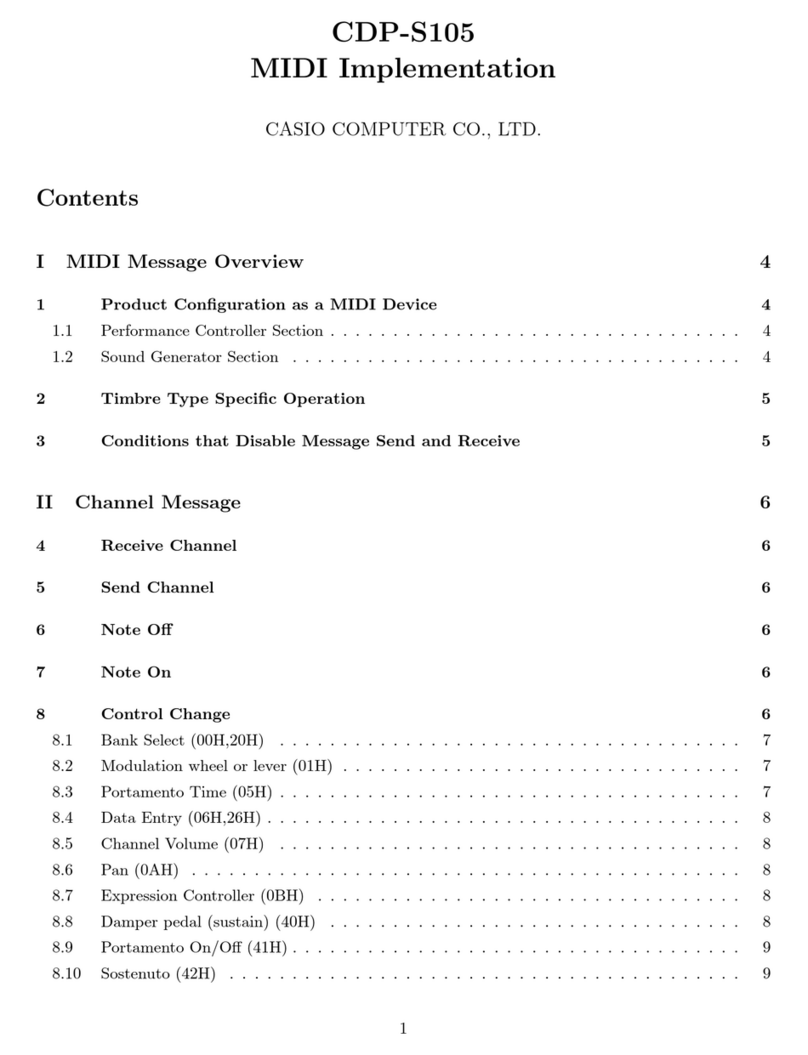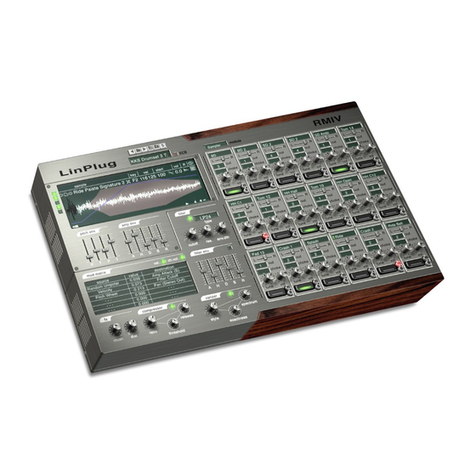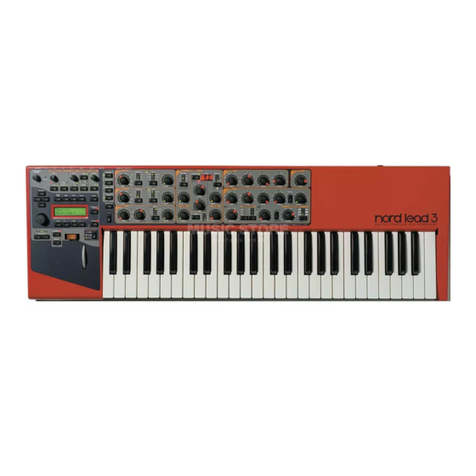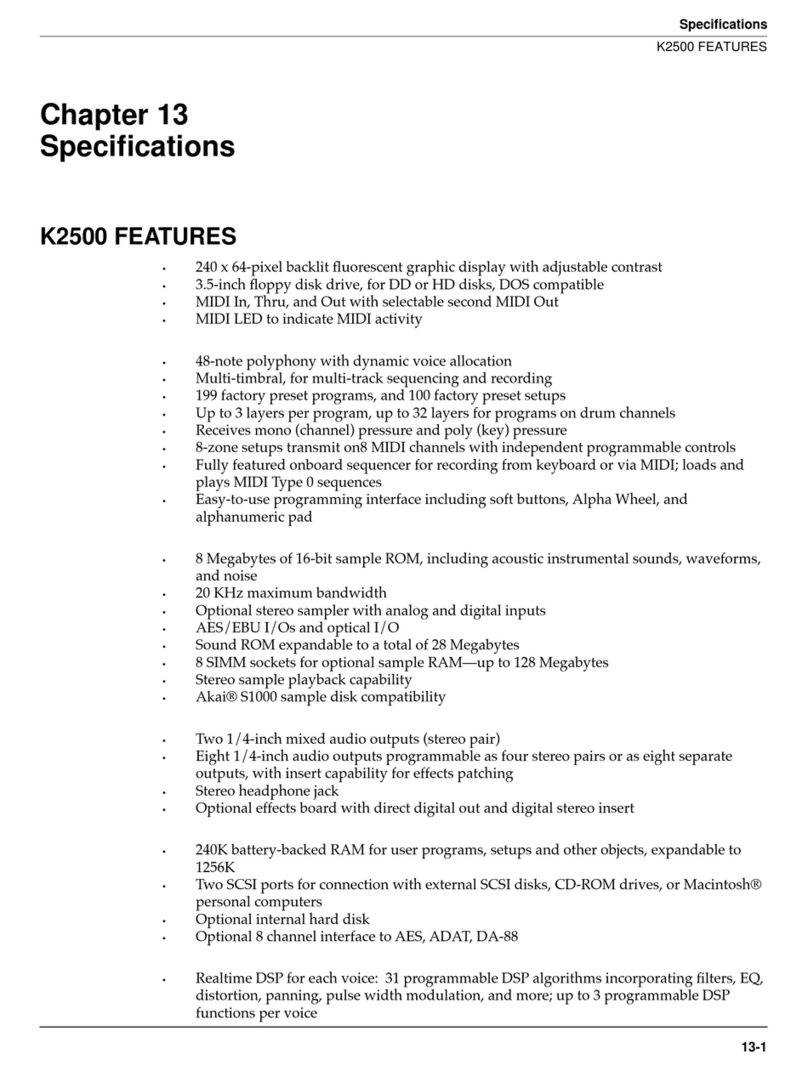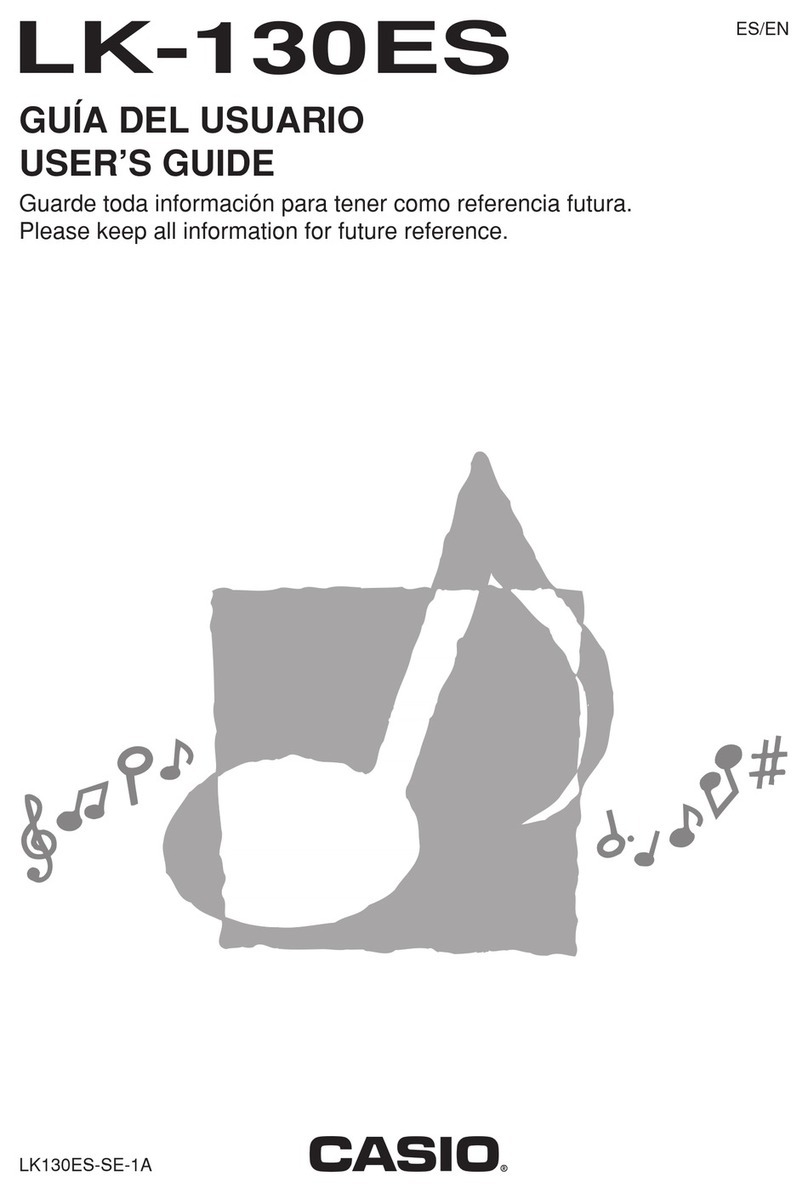CreamWare Noah Arpeggiator User manual

Index 1Arpeggiator Contents
Introduction
Overview
Basics
MIDI Message Handling
Control via the MIDI Keyboard
Timing and Synchronization
Slots
Functions
Big Buttons Group
Standard Page
CaptureMode
Scan Mode
ScanPattern
AutoRescan
OctaveExtend
Repeat
SweepTranspose
NoteDropout
RestNote
Additional Page
LFO Settings
MIDI Keyboard Control
OutputTiming
MainTable of Contents
Arpeggiator
-Tactive Instrument Modeller

Index 2Arpeggiator Contents
If you’re just getting acquainted with the
Arpeggiator, and if you already have a
basic idea of what an arpeggiator is,
there’s nothing at all wrong with going
straightintohands-on experimentation –
you can refer back to the manual to go
morein-depthor forclarificationofdetails
as needed. But
do
read the manual
sometime – there are features here you
wouldn't want to miss out on!
Introduction
The Arpeggiator presents you with
tremendouspossibilities:
- Use it to effortlessly (and interactively)
generatemelodic sequencesin realtime
–with myriadcontroloptions, allofwhich
can be adjusted at any time to yield
practically endless variations – for direct
use, to stimulate your own musical
imagination, or to advance the frontiers
of musical-acoustic research!
-Evenfor accomplishedkeyboardists,for
whomkeyboardtechniqueisnotanissue,
theArpeggiatorisa
fabulous
labor-saving
device!
-The Arpeggiatoris ahighly dependable
toolforbringing
any
relationship(musical
or
non-musical) to a speedy end. It's
thereforealsoasure-firevehicleforgetting
yoursolocareer(musical
or
non-musical)
off to an early start!
But seriously ...
No idea what an arpeggiator is? In
simplest terms, it's a device which
captures
chords (or short sequences of
notes)thatyouplayintoit,andthen
scans
the captured notes, periodically sending
them out one at a time, thus generating
arpeggios
from yourinput.
Theresults ofthissimpleprocesscan be
annoyingandbanal,ortrulyesoteric.Quite
alotdependsupon thesoundsyou apply
it to and the contexts you use it in. We
won't presume to prescribe these things
for you. All options are open. The
Arpeggiatorincludesenoughfeaturesand
flexibility to enable you reach
any
extre-
me!
Many features of the arpeggiator are
easier to understand intuitively than by
reading about them. If you can’t make
headsortailsof somethingyou readhere
– just go ahead and try it out.You can’t
damage anything.Then come back here
and reread the section in question and
it’ll probably make perfect sense.

Index 3Arpeggiator Contents
Overview
Basics
This is a MIDI arpeggiator device:
- It is driven by MIDI note events on its
MIDIinput,whichit
captures
initsinternal
chordbuffer.
- It continually
scans
this chord buffer
according to the current settings and
producesMIDI noteevents asoutput.
(Note: in this text, MIDI note event and
other input is referred to as coming from a
MIDI keyboard, although the arpeggiator
can of course be driven by
any
live or
sequenced source of note events.)
Thearpeggiatorismonophonic.Itputsout
one note at a time, no overlapping notes
andno chords.
MIDI Message Handling
Thehandlingof receivedMIDI messages
dependson theirtype.In general:
- Received note-on messages are
capturedinthechordbuffer(uptosixteen
at any one time).
- Received note-off messages may or
may not cause the matching note-on
messagesto beremoved fromthe chord
buffer, depending upon the current
settings.
-
Received
notemessagesare
not
echoed
to the output while the arpeggiator is
running. The note events which the
arpeggiatorsendsoutareprimarily those
whichthearpeggiator itself
generates
via
scanningof thecapturedchord.

Index 4Arpeggiator Contents
- All other received
channel messages
(e.g., modwheel, pitch bend, etc.) are
echoed directly to the output at all times
andhave noparticularpre-defined effect
uponthe arpeggiator.(Ofcourse, aswith
all Noah devices, you can assign MIDI
controllers to various controls on the
arpeggiator.)
Control via the MIDI
Keyboard
A range of MIDI note numbers can
optionallybededicatedtoreal-timecontrol
ofa selectedset ofarpeggiator functions
via the MIDI input (see Big Buttons
Group, MIDI Kbd Ctrl ). This permits
thesecontrolstobeusedmoreeffectively
inreal time,as theresponseviatheMIDI
keyboard (in contrast to that of the
corresponding graphical buttons) is
virtually instantaneous. The numbers in
parentheses next to various buttons on
the surface indicate the MIDI note
numbers currently assigned to each of
these buttons or its associated
performancefunction.Theseassignments
can be changed via the MIDI Kbd Ctrl
Optionsgrouponthe additionalpage.

Index 5Arpeggiator Contents
Timing and Synchronization
The arpeggiator's timing resolution is 24
clocksorpulsesperquarter-note(PPQN).
The note-on and note-off events it
produces are aligned to these time
increments.
Slots
You can assign several instances of the
Arpeggiator, so that each slot can have
itsown.
Use the switches - the number of which
dependsupontheoperatingmode(
Single,
Multi
) and the hardware version (Noah,
NoahEX) - toselect thedesired instance
fordisplayand editing.

Index 6Arpeggiator Contents
Functions
This section presents a point-by-point description of the buttons and other controls on the arpeggiator surface.The
discussion here is broken down into sections which correspond to the organization of the surfaces/pages
Standard
and
Additional
itself:
StandardPage AdditionalPage

Index 7Arpeggiator Contents
This is the set of large buttons located at
the bottom of the arpeggiator.These are
essentiallythe"running"controls.Viewed
asagroup,theyproduceimmediate,"big"
changes. This distinguishes them from
settings
– i.e, all
other
controls on the
surface –which canlikewise beadjusted
at any time, but whose effects are less
"major" and not always immediately
audible.
Eachofthefunctionsassociatedwithone
of the Big Buttons can also be actuated
from the MIDI keyboard (see MIDI
Keyboard Control). This is generally a
betterwaytogo,astheresponse ofthese
functions to MIDI control is virtually
instantaneous.Thenumberinparentheses
beloweachofthese buttonsindicates the
MIDI note number currently assigned to
it.Theseassignmentscanbechangedvia
the MIDI Kbd Ctrl / Ctrl base parameter
onthe
Additional
page.
Big Buttons Group
Run/Stop:This is the On/Off button – it
alternately activates and deactivates the
arpeggiator. Stopping the arpeggiator
clearsthechordbuffer andterminatesthe
currentoutputnote,ifany.Notethatwhen
the arpeggiator is not running, it passes
all
received MIDI events directly through
toits output, andthe otherbuttons inthis
grouparedisabled.
Clear:Pressing thisbutton"empties" the
arpeggiator (i.e., clearsthechord buffer),
permitting a completely new chord to be
captured.Thearpeggiatorcontinuestorun
asbefore.
Clear also deactivates Hold and Hold/
Trans if they are active (see below).
Hold: This function freezes the chord
buffer, lockingthe currentcapturedchord
into the arpeggiator.Incoming MIDI note
events are no longer captured, nor can
theycause thenoteswhich havealready
been captured to be removed. Instead,
received MIDI note events are passed
directly through to the output. This lets
you "accompany"the arpeggiatorlive.
Once activated, Hold can be deactivated
only via Clear or Run/Stop.
Note: Hold isalso activated automatically
whenever Hold/Trans (see below) is
activated.

Index 8Arpeggiator Contents
Scan Dir:
Note: this function is effective
only
when
Scan Pattern is set to Fwd-Rev.
Hitting this button causes a reversal of
the instantaneous arpeggiator scan
"direction".
For example, when the arpeggiator is
producing notes going up the scale/
keyboard, Scan Dir will cause it to
reverse and go down the scale instead,
beginning with the next output note –
without affecting the output timing in any
way.
ReScan: This function "restarts" the
arpeggiatorscaneach timeit isactuated.
The next arpeggiator output note is the
onewhichshouldappear"first",basedon
thecurrentScanModeandothersettings
(for example, the lowest note in the
currentcaptured chord).
Hold/Trans: Activating Hold/Trans will
instantlyactivate Hold (seeabove) ifitis
notalreadyactive,thusfreezingthechord
buffer. While Hold/Trans is active, the
arpeggiator output can be ”live-
transposed”upordown(simplesemitone
transpose)from theMIDI keyboard.
The transpose produced by playing any
noteonthekeyboardisequalto theoffset
ofthisnote relativetomiddleC (MIDI60).
WhileHold/Trans isactive, thekeyboard
has no effect upon the captured chord,
otherthan transposingit asdescribed.
However, Hold/Trans (unlike Hold) can
beactivatedanddeactivatedfreely.When
Hold/Trans isdeactivated,Hold remains
active, as does the last transpose value
applied under Hold/Trans. This allows
switching between transposition and
accompaniment of the frozen (and still-
transposed)chord.
The transpose produced under Hold/
Trans is cleared via Clear or Run/Stop,
and is thus always zero whenever Hold
or Hold/Trans is first activated.

Index 9Arpeggiator Contents
Standard Page
Normal: In this mode, captured notes
remaininthe chordbuffer onlyforaslong
as the corresponding key is held down.
The arpeggiator output pattern varies
dynamically as keys are released.When
no keys are being held down, the
arpeggiatorproduces nooutput.
Auto Hold: Under Auto Hold, captured
notes remain in the chord buffer
indefinitely, even after all held keys have
beenreleased.Thearpeggiocontinuesto
play asifall keyswhichhavebeen played
werestill beingheld.New notescontinue
to be captured as long as at least one
key is still being held. The first note or
chordwhichisplayedfollowingtherelease
ofallkeysbeginsanewcapture"session",
at the same time clearing all previously
capturednotes.
Capture Mode
These settings control the way in which
receivedMIDInotes are
captured
to(and
removed from) the chord buffer. One of
thefourpossiblemodes isalwaysactive.
In all capture modes, the arpeggiator
keepstrackoftheorderinwhichcaptured
notesarrived,inadditiontorecordingnote
number (of course) and velocity for each
note.Thus,theuse ofboth NoteNumber
and Note Order scan modes is always
possible,regardlessoftheCapture Mode
setting.
Thecapturemodesettingcanbechanged
at any time. In some cases, after doing
this,youmayneedto useClear to empty
the chord buffer completely (e.g., if you
change from Auto Hold to Normal after
releasing all keys).
Extend1:Notes areadded tothe chord
buffer as they are played and remain in
thechordbufferindefinitely.Thiscapture
modepermits notesto beadded oneat
atime.Extend modethusmakesiteasy
to create melodic arpeggios – a
particularnotecanappearmultipletimes
atdifferentpoints withinthe arpeggio.
Note capture continues until the chord
buffer is full (sixteen captured notes).
TheClear button mustbe usedto clear
the chord buffer and silence the
arpeggiator, or to capture a new chord.
Note that Scan Mode (see following
section) must be set to Note Order in
order to have the arpeggiator play the
notes back in the order in which they
were captured.

Index 10Arpeggiator Contents
Extend 2: Same as Extend 1, but new
notes push old notes out of the chord
bufferoncethespecifiednotecapturelimit
n
(adjustable via the adjacent text fader)
hasbeenreached.
Notecapturecanthuscontinueindefinitely
– the chord buffer always contains (at
most)thelast
n
notescaptured.Therefore,
therhythmof thearpeggiator outputalso
remains fixed as new input notes are
captured,oncethelimithasbeenreached.
The note capture limit can be set to any
valuebetween2and16notesand canbe
adjustedwhilethearpeggiator isrunning.
Scan Mode
This control selects the basic method
used to scan the captured chord and
determinethenextnote tobeplayed.The
currently selected scan pattern (see
below) produces a specific variation on
the selected scan mode.The scan mode
setting can be changed at any time.
Note Order: Scanning of the captured
chord is done on the basis of the time
sequence in which the notes were
captured.
Note Number: Scanningof thecaptured
chord is done on the basis of note
numbers – e.g., from lowest note to
highestnote.

Index 11Arpeggiator Contents
Scan Pattern
Thesecontrolsdeterminethespecificway
in which the captured chord is scanned.
These settings work in tandem with the
Scan Mode setting. The Scan Pattern
setting can be changed at any time.
Forward:Thecapturedchord isscanned
inorderof increasingnotenumber (Scan
Mode setto Note Number) orinforward
time sequence (Scan Mode set to Note
Order).
Reverse:Thecapturedchord isscanned
inorderofdecreasingnotenumber(Scan
Mode setto Note Number)or inreverse
time sequence (Scan Mode set to Note
Order).
Fwd-Rev:Scanningofthecapturedchord
scan alternates between Forward and
Reverse as described above, reversing
itself each time it reaches the "end" of a
scan(highest/lowestorfirst/lastnote).The
notes at either "end" of a scan are not
repeatedwhenthedirectionreverses(i.e.,
these notes get played only once, not
twice).
Random: Chord scan follows a random
pattern. The Depth control, which is
availablewhen Randomisselected, sets
thedegree orrangeof randomness.
Random scanbehaves differently under
different Scan Mode settings:
- If Scan Mode is set to Note Number,
thenRandom scanisbasically a variation
on normal Fwd-Rev. The scan proceeds
in single steps from one note number to
the next without skipping over any notes,
but reverses its direction at random.With
Depth settominimum,this mode is in fact
equivalent to Fwd-Rev. With Depth set to
maximum, the scan reverses itself after
almosteverynote(andthustendsto"stick
in place", continually alternating between
two notes).
- If Scan Mode is set to Note Order,
thenRandom scan selects outputnotes
randomlyfrom among allpossibleoutput
notes, taking the captured chord and all
othersettings(includingOctave Extend
– see Output) into consideration. The
Depth control confines this selection to
a specific range of "scan steps" away
fromthe previous note ineitherdirection.
With Depth set to minimum, the
arpeggiator"sticks"onasinglenote.With
Depth set to maximum, the arpeggiator
mayselect any note within16scansteps
of the previous note – in effect, almost
totallyrandom.

Index 12Arpeggiator Contents
Auto Rescan
When this function is enabled, the
arpeggio is automatically re-processed
oncethenumber ofnotesas indicatedby
Length is reached. This is useful for
imposing a specific rhythmic count or
"looplength"ontheoutputwhichdoesnot
dependuponthenumberofcapturednotes
or other scan settings.
Theautorescancounterisresetwhenever
new notes or chords are played on the
MIDI keyboard (see also Mode below) –
however,
not
whileHold orHold/Trans is
active. It is also reset whenever the
manualReScan function isactuated(via
thegraphicalbutton orthe corresponding
MIDI key).
The auto rescan counter can also serve
as a resynchronization source for the
LFO.
Mode:Thissettingsspecifieswhether the
Auto ReScan counter should be reset
whenever any new note is played on the
MIDIkeyboard(New Notes)oronlywhen
new
chords
are played(New Chords).
Thedifferencebetweenthesetwochoices
is that with New Chords, only the first
note which is played
after all keys have
beenreleased
(e.g.,thefirstnoteofanew
chord)will causethe counter tobe reset,
whereas with New Notes, every note
which is played will cause the counter to
bereset, evenifother keys arestill being
helddown.
For example: Using Normal capture
mode, you can hold down the keys of a
chord, and from time to time release
individual keys or hold down new ones to
modify the arpeggio while it plays. With
Mode:New Chords,adding of new notes
can be done at any time without changing
the rhythm or shifting the "downbeat" of
the resulting arpeggio. With Mode:New
Notes, each new note you play redefines
the downbeat to that point in time, cutting
the current "bar" short and immediately
beginning a new one – thus allowing you
to redefine the dowbeat as you go, follow
time-signature changes on the fly, etc.
Notethat theMode setting alsoaffects
keyboard-driven resynchronization of
the LFO (when the option New Note/
Chord isactivated –seeLFO Settings
–ReSync LFO).
Note Length: Controls the playback
lengthof thenotes inthe arpeggio.
This setting also influences the LFO
speed if the LFO Speed – Beats/Clks
optionis enabled(see LFO Settings).

Index 13Arpeggiator Contents
Gate Duration :This setsthe proportion
ofeacharpeggiatorbeatduringwhichthe
output note remains in the gate-on
(sustain)state. Adjustmentofthissetting
through its full range from minimum to
maximum produces a gradual change in
the arpeggiator output from staccato to
legato.The number of clocks for gate-on
and gate-off phases, respectively, are
displayed for reference – these values
cannotbe adjusteddirectly.
Note that this control will have no effect
at the minimum from
Note Length
, since
inthat case,the onlyavailable possibility
isone clock for gate-onand onefor gate-
off.
Velocity: These settings provide control
over the note-on velocity of arpeggiator
outputnotes (Note-On-Velocity).
Use Orig Velocity / Replace Velocity:
One of these two options is always in
effect:
- When Use Orig Velocity is selected,
outputnotes havethe note-onvelocityof
the captured note from which they were
generated(andtheothervelocitycontrols
describedbelowhave noeffect).
-WhenReplaceVelocity is selected,the
velocity values of the captured notes are
ignored. Instead, output note velocity is
determinedby thefollowingcontrols.It is
possible to switch back and forth freely
between these two modes – the actual
capturednotesarenotaffectedinanyway
andtheoriginalvelocityvaluesarealways
available.
This has no influence over the captured
notes whose original dynamics can
alwaysbe restored.
LFO Modulation: This setting regulates
modulation of output note-on velocity by
thearpeggiator’sbuilt-inLFO.Thissetting
is effective only when Replace Velocity
is selected (see above).
LFO modulation causes the velocity
valuesofarpeggiatoroutputnotestovary
over time. It functions by decreasing
velocities relative to the Max Velocity
value (see above). In effect, the LFO
Modulation control sets the minimum
modulatedvelocity.
For example:
- At the maximum LFO Modulation
setting, velocity values vary between the
Max Velocity setting and the absolute
minimum possible MIDI velocity value of
1.
- At the "halfway” setting, by contrast,
velocity values still reach MaxVelocity at
the high end of the modulation swing, but
atthelowend,theygoonlyhalfasfardown
– i.e., to roughly one half of MaxVelocity.

Index 14Arpeggiator Contents
Octave Extend
Producescyclicalupwardtranspositionof
the arpeggiator output by one or more
octaves. The transpose amount is
automatically "stepped" by one octave
each time the arpeggiator completes a
scan of the captured chord in the current
scandirection.Thecaptured chordisthus
effectivelyextendedintoadditionalhigher
octaves as if the actual notes in the
captured chord had been duplicated in
thoseoctaves.Setting Octave Extend to
zero disables it.
"Stepping" of the Octave Extend
transpose amount is always done in a
manner which is consistent with the
selected scan pattern. Assuming that
Octave Extend isenabled (i.e,itis setto
1 or higher):
- With Scan Pattern set to Forward,
output transpose is stepped upward by
oneoctavefollowingeach passthrough
thecapturedchorduntiltheuntilthescan
in the highest octave (as specified by
theOctave Extend setting)iscomplete.
Transpose is then reset to 0 and the
cycle repeats.
- With Scan Pattern set to Reverse,
output transpose is stepped downward
by one octave following each pass until
ascanwithatransposeof0iscomplete.
Transpose is then reset to the highest
octave (as specified by the Octave
Extend setting) and the cycle repeats.
- With Scan Pattern set to Fwd-Rev,
the scan direction is not reversed upon
completion of a single forward scan of
the captured chord, as would normally
occur. Instead, output transpose is
stepped upward by one octave and
another forward scan is done. This
repeats until the forward scan in the
highest octave is complete – at this
point, the scan direction reverses and
the reverse scan is done, still in the
highest octave. Subsequently, output
MaxVelocity:Adjustablebetween 1and
127. This setting is effective only when
Velocity:Replace is selected (see
above).
- When LFO Modulation (see below) is
set to zero, this setting
directly
specifies
thevelocity ofoutputnotes, whichisthen
constant.
-Otherwise,itsets themaximumvelocity
value whichmodulatedoutput notesmay
have. Modulation by the LFO results in
time-varying velocity values which are
lowerthan thismaximum.
(By the way – the Max Velocity control is
another
excellent candidate for
assignment to a MIDI controller.)

Index 15Arpeggiator Contents
transpose is stepped downward by one
octave each time a reverse scan is
complete(likewise,withnoscandirection
reverse) until a scan with a transpose of
0 is is complete.The scan direction then
switches again to forward and the entire
cycle repeats.
-WithRandom scanpatterns,theOctave
Extend setting correspondingly extends
(by the specified number of octaves) the
set of possible output notes which the
random scan can produce – again, as if
the actual notes in the captured chord
havebeen replicatedinhigher octaves.
Repeat
When set to values other than zero, this
setting causes the arpeggiator to repeat
eachoutputnoteforthespecifiednumber
of additional beats before proceeding to
scan the captured chord for a new note.
Repeat works with all scan modes and
scanpatterns.
SweepTranspose
This function can be used to produce a
dynamically variable "chord inversion"
styleofupwardtranspose.Progressively
higher settings cause the currently
lowest
output
note to be transposed
upward by one or more full octaves so
thatitbecomesthe highestoutputnote,
ineffectrolling or"sweeping"theoutput
pattern up the keyboard one note at a
time – but without altering its "chord
value".
SweepTranspose works with all scan
modes and scan patterns. The control
is ranged for a maximum transpose of
four octaves and automatically bases
itself with respect to the lowest note
actually being played on the keyboard
atanytime.(Hint:theSweepTranspose
control is a
natural
for assignment to a
performancecontroller or anotherMIDI
Controllerfor"live"adjustmentfrom the
keyboard.)

Index 16Arpeggiator Contents
Note Dropout
Thesecontrols canbeleft settozero (full
left) for normal use.Increasing the Note
Dropout setting away from zero results
inanincreasinglyprobabilitythatanoutput
notewill "dropout",or notappear, onany
givenbeat. Atthemaximum setting,note
output is completely suppressed. Scan
timing and sequencing is otherwise not
affected – these continue to function
accordingtoscanmodeandscanpattern
settings,Repeats / Note,etc., asthough
the dropped notes had been played
normally. Note Dropout works with all
scanmodes andscan patterns.
The two Note Dropout controls are
identicalin theireffect.TheNorm control
is the one whose setting is normally
applied. The Alt control setting applies
onlywhileholdingdowntheMIDIkeyboard
key assigned to the Note Dropout Alt
function(see MIDI Keyboard Control).
This can be used for a variety of effects.
The simplest one is to set the Norm
control all the way to the right (100%
dropout) and the Alt control full left.With
these settings, arpeggiator output notes
appear continously while the Note
Dropout SHIFT key is held down – but
only
then.
Or, with the opposite settings, the Note
DropoutAltkeybecomesa"manualrest"
or mute key, blocking arpeggiator output
aslongasitishelddown(butnotaffecting
its timing in any way).
Moregenerally,theNote DropoutAltkey
can be used to switch instantly back and
forthbetween
any
twonotedropoutrates.

Index 17Arpeggiator Contents
Rest Note
Thiscontrol permitsa specificMIDI input
note to be designated as a "rest" note.
Whenever the arpeggiator lands on this
noteduringascan ofthecaptured chord,
it inserts a rest – i.e., no output note is
generatedforthisscan step.The inserted
rest extends to include repeat notes, if
any(see Repeat).
The Rest Note feature can be used to
produce syncopated arpeggios in Note
Order scan mode (hint: this is easiest
withone oftheExtend capture modes).
The Rest Note setting can be changed
freely while the arpeggiator is running,
with the result that rests appear at diffe-
rentpointsintheoutput.SettingRestNote
to Off (=128) disables the rest note
function.
The scan mode can be switched to Note
Number while the rest note function is
active without any ill effects.This merely
results in all rests (if there is more than
one) occurring consecutively, since they
are (of course) all generated from notes
havingthesame notenumber.

Index 18Arpeggiator Contents
Phase: This setting adjusts the starting
phase of the LFO – i.e., the point in its
waveformtowhich theLFO springswhen
it is resynchronized.
Tip:"Good"valuesforthissetting depend
upon the selected waveform (see the list
above).Setting ittozero causestheLFO
toresynctoa"zero-crossing"point,which
isnotalways themostinterestingstarting
point:
-For Saw Up and Saw Down waveforms,
a setting of 180° or -180° restarts the
waveform at one "end", so that the
modulation "ramps" up or down starting
from one extreme of its range.
- Similarly, Triangle waveforms are
resynchronized to positive and negative
"peaks” with phase settings of 90° and -
90°, respectively.
- By contrast, the Square waveform has
only two values (+Max and –Max).
Therefore, it doesn’t "ramp” at all, but
instead (as applied to note-on velocity)
produces simple loud/soft rhythmic
accenting – the Phase setting merely
affects the "positioning” of this rhythm.
- Finally, the Phase setting has no effect
upon the Random waveform, which
maintains a single constant (but random)
value over the duration of each LFO
waveform cycle.
Additional Page
LFO Settings
Thesesettingscontrolvariousparameters
of the built-in LFO, which can be used to
modulateoutputnote-onvelocity.
Note: Velocity must be set to Replace,
and
LFO Mod (in the same group) must
be set higher than minimum, in order for
the controls in the LFO Settings group to
have any effect.
Waveform:FivedifferentLFOwaveforms
are available: Square, Sawtooth Up,
SawtoothDown,TriangleandRandom.
Notethat theLFOisappliedto velocityin
a negative direction.That is, higher (i.e.,
more positive) instantaneous LFO
waveform values correspond to
lower
outputnote-onvelocities.Thus,Sawtooth
Upcausesvelocity todecreasegradually
with time and then jump back up to
maximum.

Index 19Arpeggiator Contents
LFO Speed:Twomethods ofLFO speed
controlare available:
Beats/Clks:Activatingthisoptionpermits
theLFO speedtobe specifiedinterms of
anumberofwholearpeggiatorbeatsand
individualclocks(fractional beats).Under
Beats/Clks, the LFO waveform goes
through a complete cycle over precisely
thespecifiedamountof "rhythmical"time.
Withthisoption,LFOspeedisbasedupon
currenttempo andbeatandadjustsitself
accordinglyifeither thebeat length(Note
Length) orthetempo ischanged.
Freq HZ:This permits LFO frequency to
bespecified directly(inHz). Ifthisoption
is enabled, the Frequency control will be
available.With this option, LFO speed is
completely unrelated to beat settings or
tempo and is unaffected by changes to
either of these.
ReSync LFO:The LFOcan berestarted
or
resynchronized
byvariousinternaland
externaleventstohelpproducecontrolled
(orout-of-control) rhythmic effects.Upon
resync, the LFO waveform jumps to the
point determined by the Phase setting
(above).
Thereare four resyncsources whichcan
be enabled singly or in any combination.
AswitchResyncLFO permitsLFOresync
enable/disablewithouttheneedtoenable/
disablethe individualsources.
Internal:Thisindicatesan"internal"scan
restart. That is: in the course of normal
scanning,thearpeggiatorhasonceagain
returnedtothe "start"ofits outputpattern
– e.g., the lowest output note.The timing
of this event depends entirely upon the
captured chord and all relevant scan
settings. Correspondingly, it varies
dynamically as the chord and/or settings
arechanged.
It should be mentioned that the
arpeggiator, as a device which responds
dynamically to its input and its settings,
doesnotactually"know"inadvancewhen
an internal scan restart will occur, but
merely detects this
when
it occurs.This
means that LFO resync in response to
internal scan restart occurs just barely
too late to have an effect upon the "first"
or scan restart note sent out by the
arpeggiator–instead,theresynchronized
LFO is applied starting with the
subse-
quent
output note. This is not an issue
with the other LFO resync sources.

Index 20Arpeggiator Contents
Manual: This indicates a scan restart
triggered via the ReScan button or the
correspondingMIDIkey.Whenthissource
is enabled, the LFO is resynchronized
whenever either of these occurs.
Auto ReScan: This indicates a scan
restarttriggeredbytheAutoReScanbeat
counter (see Scan Pattern – Auto
ReScan). When this source is enabled,
the LFO is resynchronized periodically,
accordingtothenumberofbeatsspecified
forAuto ReScan.
Notethat theAuto ReScan beatcounter
can be used to trigger LFO resync
regardless
of whether Auto ReScan is
itself currently enabled. Likewise, the
options affecting the restarting of this
counter(seeAuto ReScan– ReSync Ar
Upon:) also remain in effect when Auto
ReScan is disabled, and thus affect the
resynchronization of the LFO under this
option.
New Note/Chord: When this source is
enabled, the LFO is resynchronized in
responsetoactivityontheMIDIkeyboard
– i.e., whenever any new note is played
onthekeyboard,or
only
whennew
chords
are played (as determined by the Auto
ReScan/Mode).
However,thissource isnot effectivewhile
Hold or Hold/Trans is active, but is
automatically disabled for the duration.
Thus, live accompaniment or
transposition of a "held" arpeggio via the
MIDI keyboard is possible without
upsetting the rhythm of the LFO
modulation.
Other CreamWare Synthesizer manuals
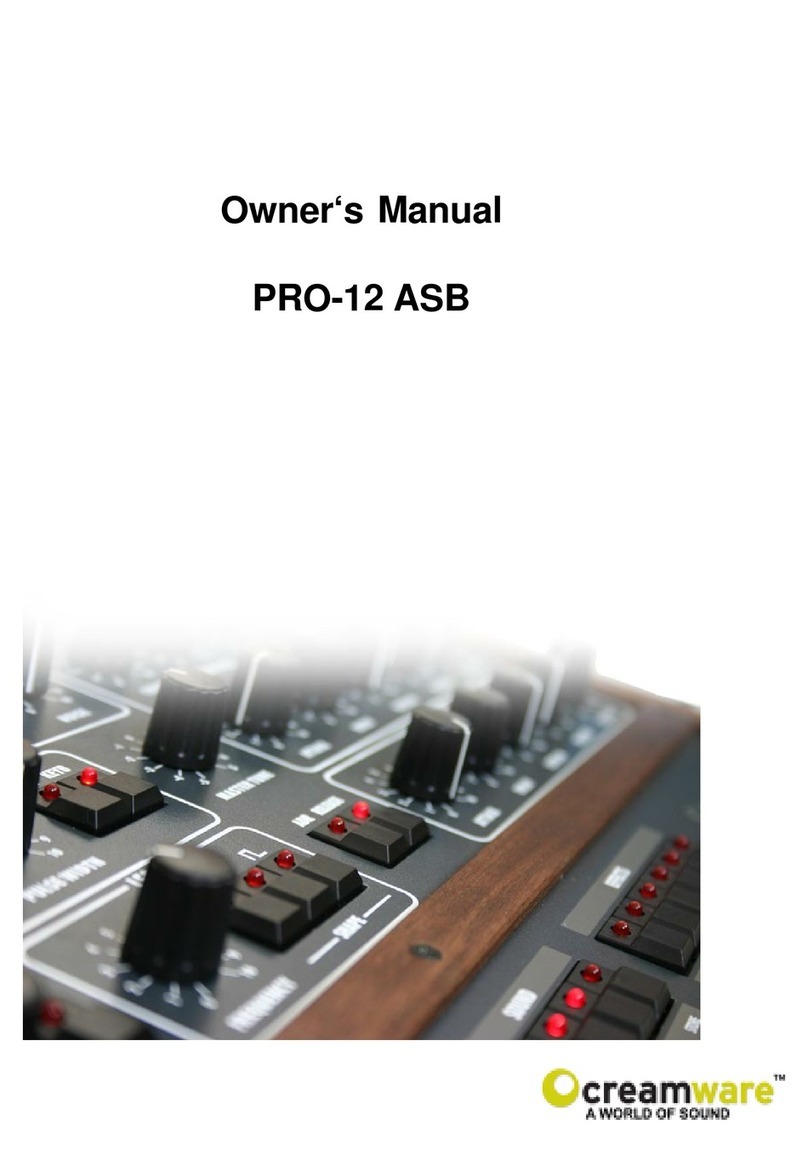
CreamWare
CreamWare PRO-12 ASB User manual
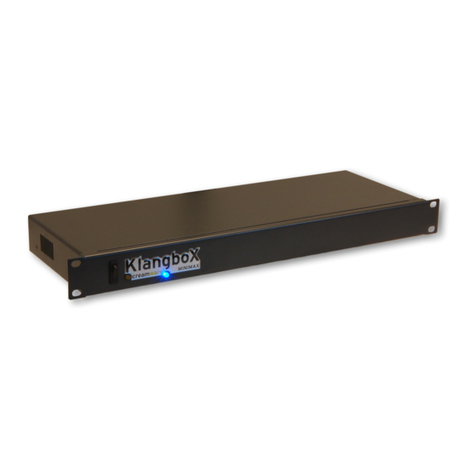
CreamWare
CreamWare Pro-12 User manual
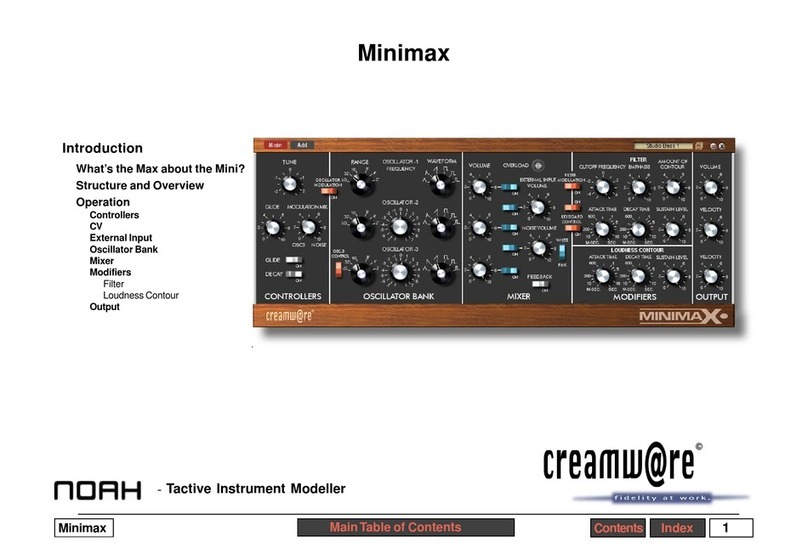
CreamWare
CreamWare Noah Minimax User manual

CreamWare
CreamWare PRO-12 ASB User manual
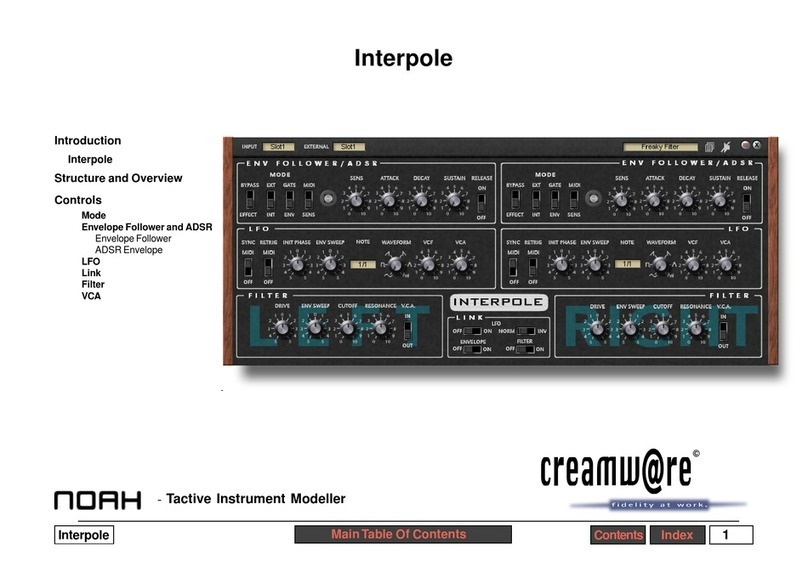
CreamWare
CreamWare Noah Interpole User manual

CreamWare
CreamWare Noah Step Sequencer User manual
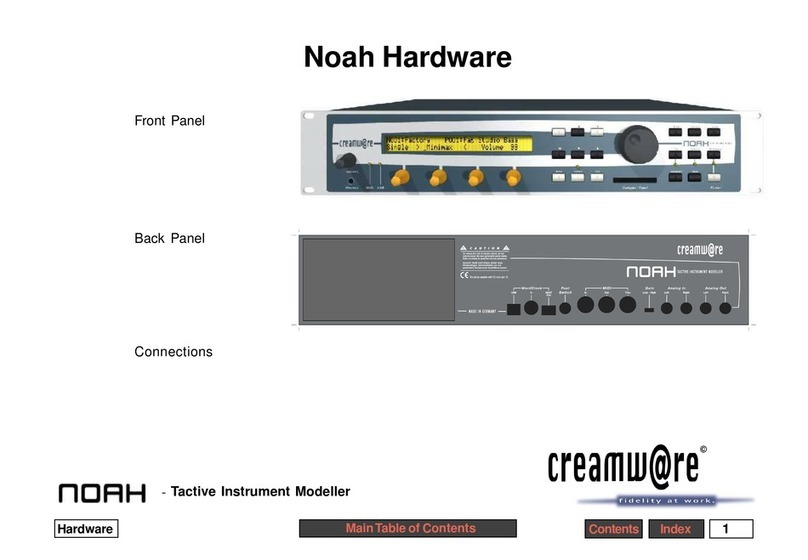
CreamWare
CreamWare Noah Installation instructions
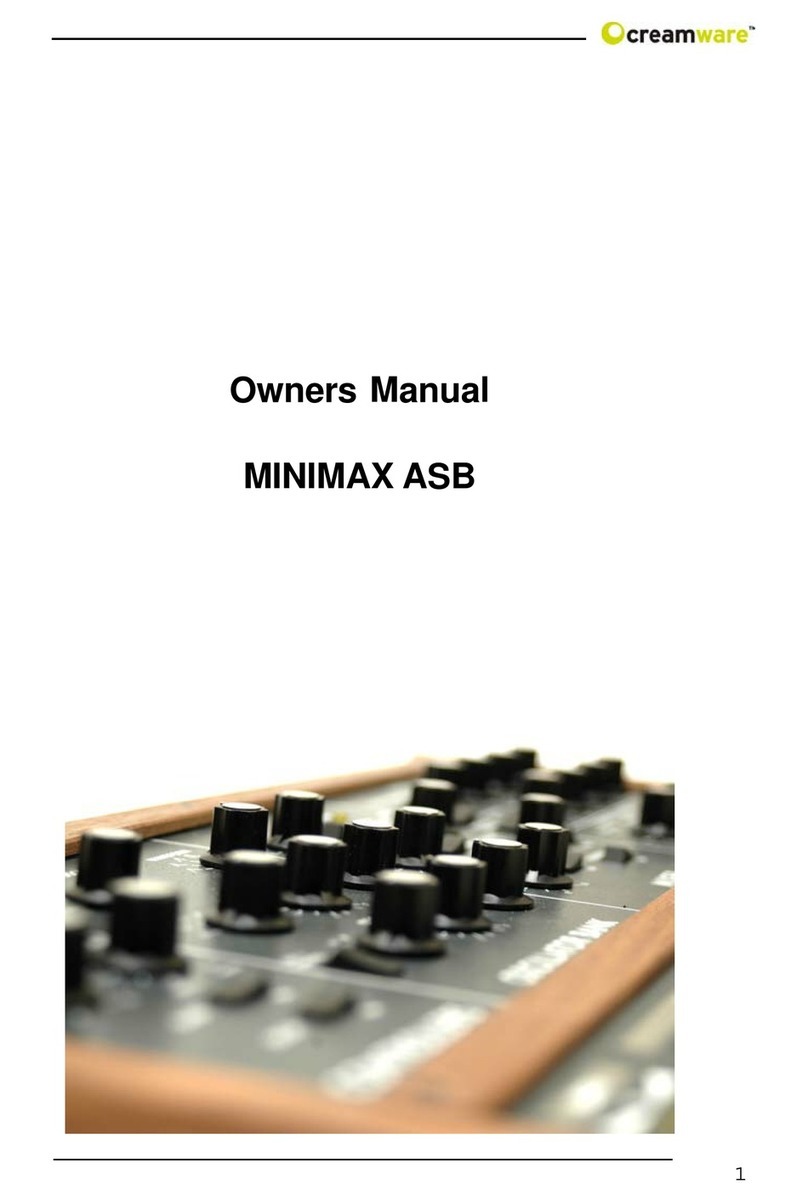
CreamWare
CreamWare MINIMAX ASB User manual

CreamWare
CreamWare Noah Vocodizer User manual
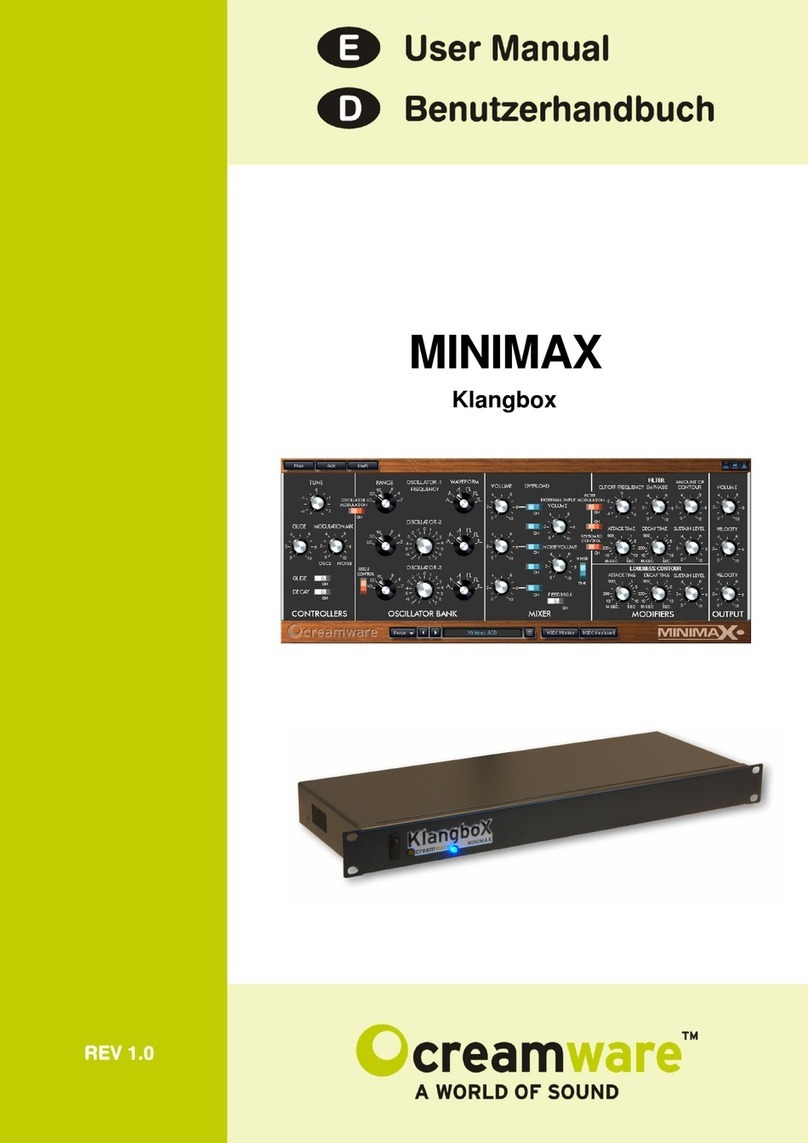
CreamWare
CreamWare MINIMAX Klangbox User manual
